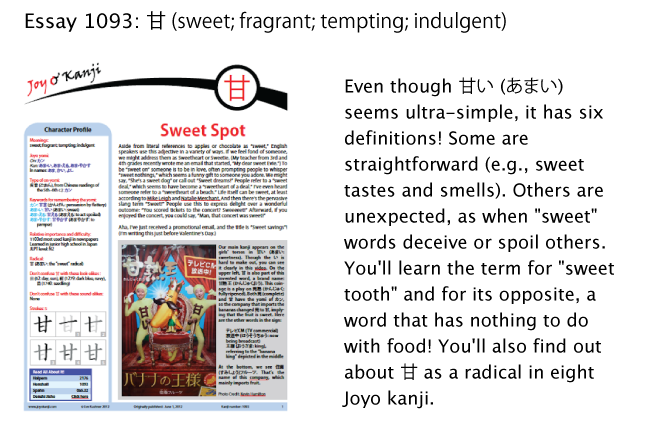Turning the Other Cheek
If you're immersed in the world of kanji, you're almost certainly aware of Jim Breen, who created the impressive and groundbreaking online dictionary WWWJDIC. I use it constantly. Nearly all the sample sentences in my essays come from that dictionary. And its text-glossing tool provides relief over and over when I encounter an overwhelming block of Japanese text. I just throw it into a box on his website, hit a button, and produce a list of yomi and definitions. Right away, everything feels clearer and more manageable.
Whenever I've emailed Breen with questions about that site or about other kanji matters, he has been helpful and responsive. Nevertheless, I was astonished to receive a guest blog from him recently, written entirely of his own volition. I was also quite surprised by the clever content. Take a look.
❖❖❖
A Tale of Two Kanji (or Perhaps Only One Kanji)
Once upon a time there was a kanji, 頰, meaning "cheek." It was a venerable kanji with an ancestry going back thousands of years. It wasn't that commonly used, but it was happy with its place in life.
But a few people in China and Japan were not entirely happy with 頰. They were The Simplifiers, and they thought 頰 was a little overweight. It could well do with a few fewer strokes. So one day they made a slimmer lightweight shadow kanji: 頬.
Now this wasn't a big problem, because they were really just the one kanji. People could happily choose whether they wrote one or the other, and people could read them both. It was a bit like the way some people in Europe write "7" with an extra stroke. We all know what it means.
Then one day, not that long ago, people in Japan began to make standard sets of numeric codes for kanji so they could be used in newfangled computers, and at the same time they prepared tables showing what the kanji looked like. For our old friend, they decided that the image for the computer code would be the slim version: 頬. And it was so. For about the next 30 years, 頬 was what appeared on screens, in computer documents, in printouts, etc., etc. Most people forgot there was ever a 頰.
But this fatter version was not entirely forgotten. Some people created a second "supplementary standard" for the kanji that missed out on being in the first one, and they decided to add 頰 there. This wasn't really a problem, as no one actually used the supplement.
Then one day, some people met in secret and declared, "There are far too many standards for characters being used in computers. There should only be ONE. Let us combine ALL the standards together!" And thus Unicode was born, and into it went both kanji standards. And so Unicode contained both 頬 and 頰. Suddenly instead of really being two shadowy versions of the same kanji, they had become two different kanji. They both meant "cheek," they were both read as キョウ and as ほほ or ほお, but they were different—they had their very own codes.
This didn't really matter at first, as no one used Unicode much in Japan. But gradually more and more people did.
And lo, one day the grey-suited men in the smoke-filled rooms in the Ministry of Education, Culture, Sport, etc., etc., decided that Japanese schoolchildren weren't learning enough kanji and that a whole lot more had to be added to the 常用漢字. On the list to be added was our old friend Mr. Cheek.
But wait! Which Mr. Cheek? There are two! Well, the grey-suited men in the Ministry of Whatever had an answer. One thing they had learned in their law courses at Tokyo University (everyone in the Ministry of Whatever is a law graduate from Tokyo) is Never Simplify! So into the 常用漢字 went 頰. Its slim younger brother 頬, which is found in computer files and electronic dictionaries all over Japan, was left out in the cold. It didn't matter that no one actually used 頰. It was the principle that counted. After all, they weren't law graduates for nothing.
So in coming years high school students in Japan will be taught to write 頰, not 頬. And if they go to look up words like 頰ずり in their online 大辞林, they won't find them because it only has 頬ずり and the codes are different. Confusion will reign. Questions will be asked but to no avail as the law graduates will have moved on by then to their 天下り jobs.
Perhaps the computer companies will start displaying 頰 for the 頬 code. That might help, and it might make things even worse. No one will know which is which. Someone will suggest that either 頰 or 頬 be abolished. No way! Unicode is immutable; once a character goes in, it will never come out. Perhaps people will ignore their teachers and stick with 頬. If they are smart, that's what they will do.
And to think, there was once only one kanji for "cheek," and now we have two. Did we really deserve it?
❖❖❖
Many thanks to Jim Breen for this valuable information and this wonderful piece of writing! If any of the kanji compounds stumped you, here's a quick rundown:
常用漢字 (じょうようかんじ: Joyo kanji)
大辞林 (だいじりん: name of a major dictionary)
頰ずり or 頬ずり (ほおずり: rubbing cheeks together (as a display of affection); pressing cheeks together)
天下り (あまくだり: (1) retiring high-ranking government officials taking a lucrative job in a private or semi-private corporation; (2) command (from superior to inferior, government to private sector, etc.); order; imposition; (3) (orig. meaning) descent from heaven)


Comments